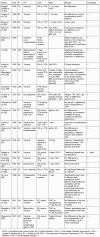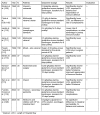Surgery and transplantation - Guidelines on Parenteral Nutrition, Chapter 18
- PMID: 20049072
- PMCID: PMC2795372
- DOI: 10.3205/000069
Surgery and transplantation - Guidelines on Parenteral Nutrition, Chapter 18
Abstract
In surgery, indications for artificial nutrition comprise prevention and treatment of catabolism and malnutrition. Thus in general, food intake should not be interrupted postoperatively and the re-establishing of oral (e.g. after anastomosis of the colon and rectum, kidney transplantation) or enteral food intake (e.g. after an anastomosis in the upper gastrointestinal tract, liver transplantation) is recommended within 24 h post surgery. To avoid increased mortality an indication for an immediate postoperatively artificial nutrition (enteral or parenteral nutrition (PN)) also exists in patients with no signs of malnutrition, but who will not receive oral food intake for more than 7 days perioperatively or whose oral food intake does not meet their needs (e.g. less than 60-80%) for more than 14 days. In cases of absolute contraindication for enteral nutrition, there is an indication for total PN (TPN) such as in chronic intestinal obstruction with a relevant passage obstruction e.g. a peritoneal carcinoma. If energy and nutrient requirements cannot be met by oral and enteral intake alone, a combination of enteral and parenteral nutrition is indicated. Delaying surgery for a systematic nutrition therapy (enteral and parenteral) is only indicated if severe malnutrition is present. Preoperative nutrition therapy should preferably be conducted prior to hospital admission to lower the risk of nosocomial infections. The recommendations of early postoperative re-establishing oral feeding, generally apply also to paediatric patients. Standardised operative procedures should be established in order to guarantee an effective nutrition therapy.
Die Indikationen für eine künstliche Ernährung sind auch in der Chirurgie die Prophylaxe und Behandlung von Katabolie und Mangelernährung. Generell sollte deshalb postoperativ die Nahrungszufuhr nicht unterbrochen werden. Ein oraler (z.B. nach Anastomosen an Kolon und Rektum, Nierentransplantation) bzw. enteraler Kostaufbau (z.B. nach Anastomosen am oberen Gastrointestinaltrakt, Lebertransplantation) wird binnen 24 h nach OP empfohlen. Zur Vermeidung einer erhöhten Letalität, besteht auch bei Patienten ohne Zeichen der Mangelernährung, die perioperativ voraussichtlich mehr als 7 Tage keine orale Nahrungszufuhr oder mehr als 14 Tage oral eine nicht bedarfsdeckende Kost (weniger als 60–80%) erhalten, die Indikation zu einer unverzüglichen postoperativen künstlichen Ernährung. Nur in Fällen einer absoluten Kontraindikation für eine enterale Ernährung wie bei einer chronischen Darmobstruktion mit relevanter Passagestörung, z.B. einer Peritonealkarzinose, besteht die Indikation zur totalen parenteralen Ernährung (TPE). Wenn der Energie- und Nährstoffbedarf durch orale und enterale Zufuhr allein nicht gedeckt werden kann, ist eine kombinierte enterale und parenterale Ernährung indiziert. Die Verschiebung einer Operation zur Durchführung einer gezielten Ernährungstherapie (enteral und parenteral) ist nur bei schwerer Mangelernährung angezeigt. Bei mangelernährten Patienten sollte die präoperative Ernährungstherapie möglichst prästationär durchgeführt werden, um das Risiko nosokomialer Infektionen zu senken. Prinzipiell gelten die Empfehlungen des frühzeitigen postoperativen Kostaufbaus auch für das Kindesalter. Zur Sicherung einer effektiven Ernährungstherapie sollten klinikintern standardisierte Schemata erstellt werden.
Keywords: fast track surgery; postoperative nutrition; surgery; transplantation.
Figures






References
-
- Velanovich V. The value of routine preoperative laboratory testing in predicting postoperative complications: a multivariate analysis. Surgery. 1991;109(3 Pt 1):236–243. - PubMed
-
- Engelman DT, Adams DH, Byrne JG, Aranki SF, Collins JJ, Jr, Couper GS, Allred EN, Cohn LH, Rizzo RJ. Impact of body mass index and albumin on morbidity and mortality after cardiac surgery. J Thorac Cardiovasc Surg. 1999;118(5):866–873. doi: 10.1016/S0022-5223(99)70056-5. Available from: http://dx.doi.org/10.1016/S0022-5223(99)70056-5. - DOI - DOI - PubMed
-
- Kama NA, Coskun T, Yuksek YN, Yazgan A. Factors affecting post-operative mortality in malignant biliary tract obstruction. Hepatogastroenterology. 1999;46(25):103–107. - PubMed
-
- Takagi K, Yamamori H, Toyoda Y, Nakajima N, Tashiro T. Modulating effects of the feeding route on stress response and endotoxin translocation in severely stressed patients receiving thoracic esophagectomy. Nutrition. 2000;16(5):355–360. doi: 10.1016/S0899-9007(00)00231-8. Available from: http://dx.doi.org/10.1016/S0899-9007(00)00231-8. - DOI - DOI - PubMed
-
- Koval KJ, Maurer SG, Su ET, Aharonoff GB, Zuckerman JD. The effects of nutritional status on outcome after hip fracture. J Orthop Trauma. 1999;13(3):164–169. doi: 10.1097/00005131-199903000-00003. Available from: http://dx.doi.org/10.1097/00005131-199903000-00003. - DOI - DOI - PubMed
Publication types
MeSH terms
LinkOut - more resources
Full Text Sources
Medical
Research Materials
Miscellaneous

